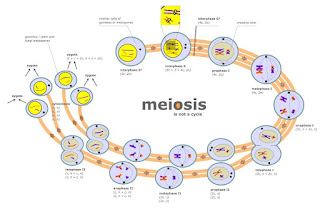 Meiosis is a type of reduction division of the
nucleus to form haploid gametes. In other words, it is the process by which sex
cells (gametes) are made in the reproductive organs.
Meiosis is a type of reduction division of the
nucleus to form haploid gametes. In other words, it is the process by which sex
cells (gametes) are made in the reproductive organs.
·
Meiosis is preceded by interphase, a stage in which cells in general, spend most of their
life in, which includes the replication
of DNA (S phase) to create chromosomes with genetically identical sister
chromatids.
·
The process of meiosis involves two divisions, both of
which follow the same basic stages as mitosis (Prophase, Metaphase, Anaphase and Telophase)
1. Prophase I
-
DNA (chromatins) supercoils and chromosomes condense.
-
Nuclear membrane dissolves and the centrioles migrate
to the poles of the cell.
-
The homologous*
chromosome associate with each other to for bivalents.
Homologous:
chromosomes that share the same structural features and the same genes at
specific loci positions.
In this case, crossing-over between non-sister
chromatids took place resulting in the
recombination of alleles, further leading to genetic variation.
2. Metaphase I
-
Random
orientation takes place in this phase where each bivalent
independently aligns resulting in the daughter nuclei receiving a different mix
of chromosomes.
-
The bivalents line up at the equator.
3. Anaphase I
-
Homologous
pairs are separated and pulled to opposing poles.
-
Spindle
microtubules (fibre) contract causing a reduction division where the bivalents have now been split in half.
Each of these now single stranded chromosomes move to opposite poles.
4. Telophase I
-
The nuclei,
which are now Haploid (N), each
contain one pair of sister chromatids for each of the species’ chromosomes.
-
The
cytoplasm begins to divide by a process called cytokinesis.
-
Chromosomes
decondense into chromatins.
5. Prophase II
-
Nuclear
membranes dissolves.
-
Sister
chromatids (chromosomes) condense via supercoiling
with the help of specialised proteins called histones.
-
Here, no crossing-over occurs.
-
Centrioles
move to opposite poles.
6. Metaphase II
-
Pairs of
sister chromatids align at the equator.
-
Spindle
fibres form and attach at the centromeres.
7. Anaphase II
-
The sister
chromatids are now separated. The centromeres are split and the chromosomes are
pulled to opposing poles through contractions of the spindle fibres.
8. Telophase II
-
Nuclear
membrane reforms.
-
Chromosomes
decondense back into chromatins.
-
Cytokinesis
begins, dividing the cells.
-
As a result,
meiosis produced four haploid gamete
cells.
-
Furthermore, fertilization of these haploid gametes will
produce a diploid zygote.
SAG
No comments:
Post a Comment